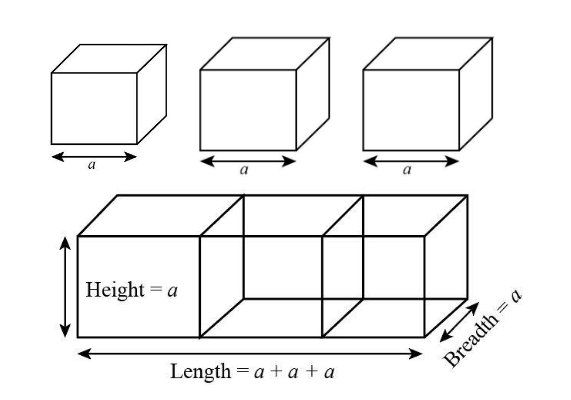
3 cubes of edge
Answer
492.9k+ views
Hint: The side of the cube is given in the question. With the help of the side of the cube, we will find the dimensions of the resulting cuboid. Then to find the surface area of the resulting cuboid,we will use the expression of the surface area of the cuboid. We will substitute the value of length, breadth and height in the expression of the surface area of the cuboid to get the final answer.
Complete step-by-step answer:
The surface area of the cuboid is expressed as:
Here
Step by step answer:
The side of the three cubes is

We can see that from the figure that after joining two cubes, one cuboid will fotext whose side can be expressed as
The length of the cuboid is:
The breadth of the cuboid is
The height of the cuboid is
We know that the surface area of the cuboid can be expressed as
We will substitute
Hence the surface area of the resulting cuboid is
Note: Whenever we join three cubes, a new cuboid is fotexted such that the volume never changes but the surface area always changes. The volume of the three cubes joined will always be equal to the volume of the cuboid. But we need to calculate the surface area as it always changes.
Complete step-by-step answer:
The surface area of the cuboid is expressed as:
Here
Step by step answer:
The side of the three cubes is

We can see that from the figure that after joining two cubes, one cuboid will fotext whose side can be expressed as
The length of the cuboid is:
The breadth of the cuboid is
The height of the cuboid is
We know that the surface area of the cuboid can be expressed as
We will substitute
Hence the surface area of the resulting cuboid is
Note: Whenever we join three cubes, a new cuboid is fotexted such that the volume never changes but the surface area always changes. The volume of the three cubes joined will always be equal to the volume of the cuboid. But we need to calculate the surface area as it always changes.
Recently Updated Pages
Master Class 9 General Knowledge: Engaging Questions & Answers for Success

Master Class 9 English: Engaging Questions & Answers for Success

Master Class 9 Science: Engaging Questions & Answers for Success

Master Class 9 Social Science: Engaging Questions & Answers for Success

Master Class 9 Maths: Engaging Questions & Answers for Success

Class 9 Question and Answer - Your Ultimate Solutions Guide

Trending doubts
Fill the blanks with the suitable prepositions 1 The class 9 english CBSE

Difference Between Plant Cell and Animal Cell

Given that HCF 306 657 9 find the LCM 306 657 class 9 maths CBSE

The highest mountain peak in India is A Kanchenjunga class 9 social science CBSE

What is the difference between Atleast and Atmost in class 9 maths CBSE

What was the capital of the king Kharavela of Kalinga class 9 social science CBSE




